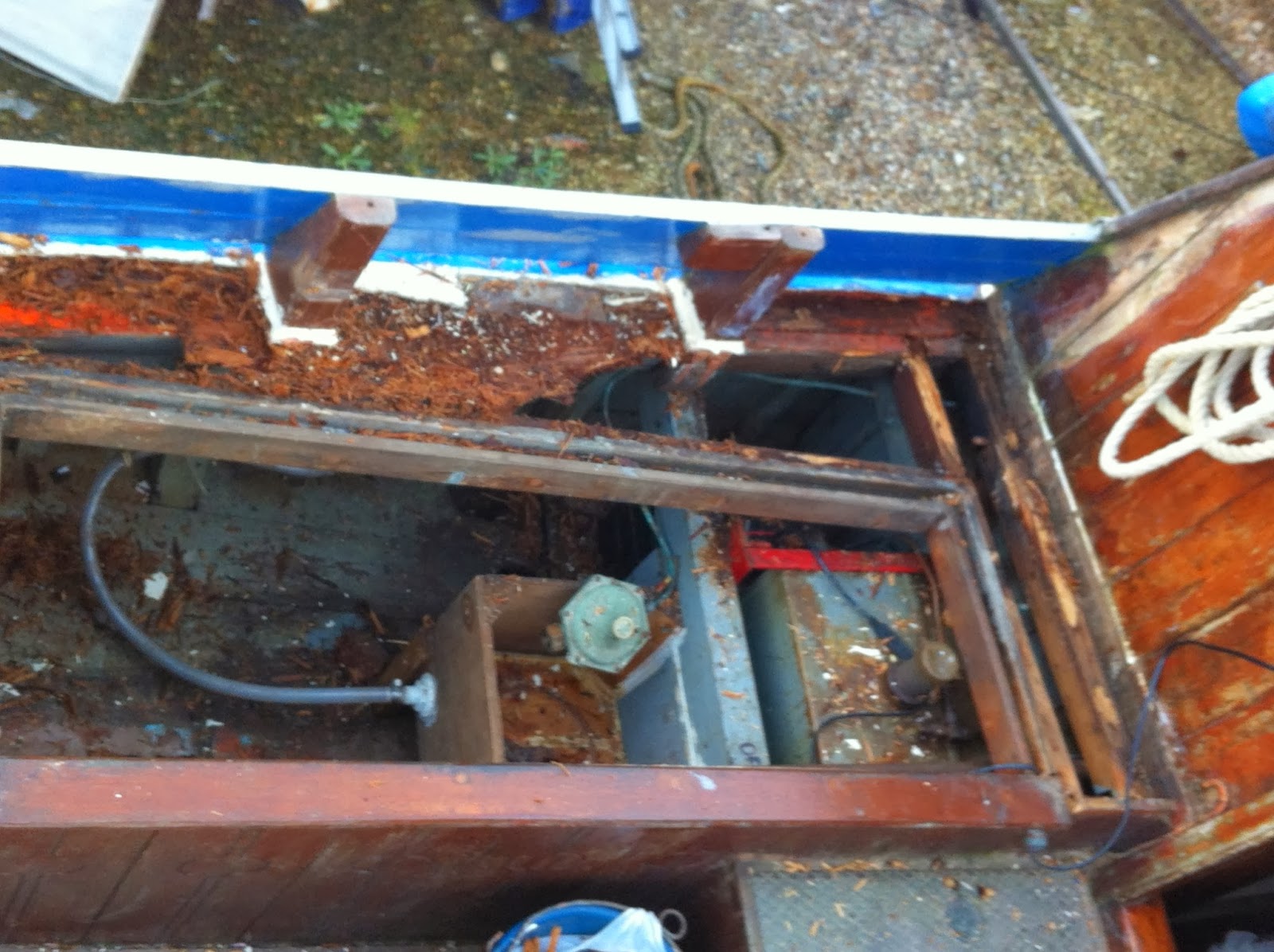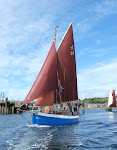Last week was half term, but I only managed to get to Robinetta twice since I had other things to do and the weather was not up to much. I took Alex both times though, and he managed to get two coats of underwater primer on while I cleaned up the cockpit some more and washed down the forepeak. I was pretty sure it would be weekend working only until April, but then I heard the school I work at on Wednesday had cancelled for this week. I checked the weather and it was forecast to be sunny.
I headed for West Mersea as soon as I had put a layer of varnish on the gaff and rudder (which are at home), and got there at 0950. The weather was perfect, so as soon as I masked up the waterline I got out the roller and anti fouled the hull. At 10C it dried quickly in the sun and breeze, and it was soon touch dry. That took the morning, then after lunch I sanded down the grey metallic primer on the bulwarks to key it in for the next coat. That makes two, so I think I'll move on to primer undercoat next time...
After that it was into the forepeak to sand down the flaking paint (mask on of course, I have no idea what paint I'm dealing with here!). I'd remembered the vacuum cleaner so I hoovered the dust up then gave the bare wood a coat of grey metallic. The problem with painting is there are so many layers to go on if you want the job to last!
I've booked Robinetta's launching slot at the end of the first week of April. Fingers crossed we're ready by then....
Wednesday 26 February 2014
Monday 17 February 2014
Dry and Sunny!
Every fine day means we should head to the boat to get what we can done, so on Sunday Julian and I drove to West Mersea hoping to get a layer of underwater primer on the hull. Julian had a look at the putty that Paul had put over the bolt heads from when he redid the floors at the bow, and decided that he was unhappy with the slight drip he got when he pressed it. The putty is still very soft. He wanted Paul to check it before he painted it over, so I got him to sand down the cabin sides that continue the white stripe of the bulwalks. The paint there has been flaking off again, so needs redoing.
The bilge pump worked as soon as I tried it, most mysterious, so I did not need to dry the bilges, and since Julian was getting on with what I had intended to do I started rubbing down the bright work in the cockpit ready for re-varnolling. I'd done about half by lunch time. Unfortunately when I went to Marinestore to buy the Varnol they told me they had discontinued it. I'll have to rethink! That left me at a bit of a loose end, since I did not want to take off any more Varnol until I'd decided what to replace it with.
While brushing down the cockpit so my sanded off varnol did not blow onto the grey metallic paint Julian was putting on the bulwark I noticed that the fibreglass sheathing that butts against the cabin edge was pulling away a bit. That led me to tap at it, and my heart sank. An area the size of a side plate on the port side of the cockpit top sounded hollow. I felt around underneath it, and pulled out a lump of fungus that seemed like a fruiting body of some sort.
When Julian drilled into the cockpit top to fit the GPS mount back in April 2009 he reported that the wood seemed a bit soft, but that was on the starboard side, and that all still sounds fine (with no ominous fungus) beneath.
I called Julian, and we decided that we had to find out what was going on, so that meant taking off the locker seat and dismantling the port side of the cockpit.

The ply beneath the hollow fibreglass crumbled like wet fibre board when we exposed it, and the support strut for the locker seat also lacked strength. We worked back, and the support strut at the stern of the locker seat was also rotted, with crumbling ply above it. The ply was fine further back though, so it seems that the problem lies with the locker supports.
I got Paul to take a look at it today, and he'll rebuild it for us before we relaunch. I've also asked him to refinish the mast, as we really don't have time to do it with the uncertainties of the weather. He saw no problems with the softness of the putty, so Alex washed the salt off the hull and painted a layer of underwater primer. It will take a while to go off, but the next dry day we get it will be back to Robinetta for more painting.
The bilge pump worked as soon as I tried it, most mysterious, so I did not need to dry the bilges, and since Julian was getting on with what I had intended to do I started rubbing down the bright work in the cockpit ready for re-varnolling. I'd done about half by lunch time. Unfortunately when I went to Marinestore to buy the Varnol they told me they had discontinued it. I'll have to rethink! That left me at a bit of a loose end, since I did not want to take off any more Varnol until I'd decided what to replace it with.
While brushing down the cockpit so my sanded off varnol did not blow onto the grey metallic paint Julian was putting on the bulwark I noticed that the fibreglass sheathing that butts against the cabin edge was pulling away a bit. That led me to tap at it, and my heart sank. An area the size of a side plate on the port side of the cockpit top sounded hollow. I felt around underneath it, and pulled out a lump of fungus that seemed like a fruiting body of some sort.
When Julian drilled into the cockpit top to fit the GPS mount back in April 2009 he reported that the wood seemed a bit soft, but that was on the starboard side, and that all still sounds fine (with no ominous fungus) beneath.
I called Julian, and we decided that we had to find out what was going on, so that meant taking off the locker seat and dismantling the port side of the cockpit.

The ply beneath the hollow fibreglass crumbled like wet fibre board when we exposed it, and the support strut for the locker seat also lacked strength. We worked back, and the support strut at the stern of the locker seat was also rotted, with crumbling ply above it. The ply was fine further back though, so it seems that the problem lies with the locker supports.
I got Paul to take a look at it today, and he'll rebuild it for us before we relaunch. I've also asked him to refinish the mast, as we really don't have time to do it with the uncertainties of the weather. He saw no problems with the softness of the putty, so Alex washed the salt off the hull and painted a layer of underwater primer. It will take a while to go off, but the next dry day we get it will be back to Robinetta for more painting.
Saturday 8 February 2014
Windy
 It seems like ages since we've been to the boat. It was supposed to be dry in the afternoon but windy. It rained hard on the way but the sun came out as we crossed the Strood and it was lovely when we got to the yard. The boat seemed quite dry but not dry enough to put a coat of undercoat on the hull. We decided to have lunch first and I snapped a few atmospheric shots from the yard and then we walked to the Company Shed. This is the view from the southern end of the yard near the house boats looking south.
It seems like ages since we've been to the boat. It was supposed to be dry in the afternoon but windy. It rained hard on the way but the sun came out as we crossed the Strood and it was lovely when we got to the yard. The boat seemed quite dry but not dry enough to put a coat of undercoat on the hull. We decided to have lunch first and I snapped a few atmospheric shots from the yard and then we walked to the Company Shed. This is the view from the southern end of the yard near the house boats looking south.The wind was incredibly strong. It blew us all the way to the Shed. We started lunch with a 1/2 dozen native oysters. Lovely. Then Alison had the lobster soup and I had mussels and we shared a salad. For once we were organised and had brought some bread and wine. A truly sumptuous lunch.
We popped in to Wyatts on the way back and bought some paint and bits and pieces. Then Alison go to work bailing out the boat. The bilge pump had blown a fuse at some point and the boat was full of water - right up to the floorboards. At least that means that Paul's caulking is working - there wasn't any running out of the hull! I got to work sanding the bulwark cap-rails in the bow. Once she was dry Alison did some cleaning and preparation in the fore-peak and then we put the covers on and came home. I took this picture of the bolts Paul replaced in the floors in the bow - the ones we didn't get done when we first bought the boat. We had them done just in time!
It was really windy all day - nothing like they are getting in the south west but it howled in the rigging of the boats around us. As the afternoon drew on it got stronger and stronger. On the way home in the car there was one gust on the A120 that nearly pushed us into the crash barrier.
Subscribe to:
Posts (Atom)





